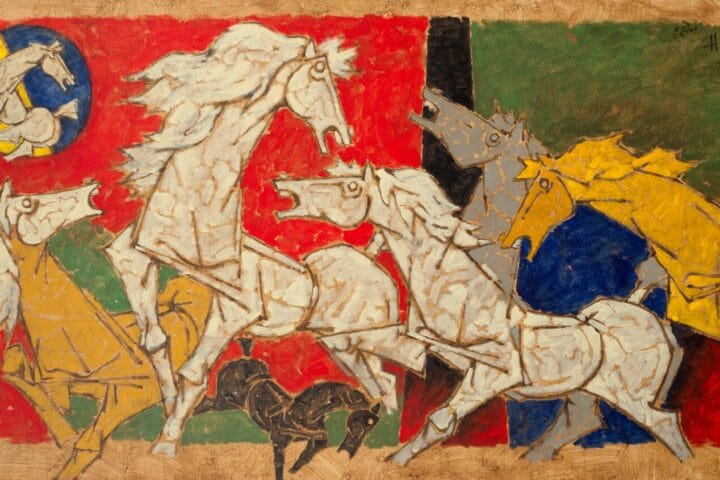New York, NY (February 21, 2023) – The Marlene Meyerson JCC Manhattan (MMJCCM) announces Veni, Vidi, Video, a multimedia gallery exhibit highlighting the role of Jewish female artists in shaping video art from the 1960s to today. The exhibit, curated by Sharon Balaban, features the work of 18 trailblazing American and Israeli artists and experimental filmmakers exploring themes of human rights, gender, and social dynamics. Opening during Women’s History Month, Veni, Vidi, Video will be on display in The Laurie M. Tisch Gallery at the MMJCCM from March 9 through May 18, 2023, and is free and open to the public.

The artists on display in Veni, Vidi, Video include Sharon Balaban, Hilla Ben Ari, Dara Birnbaum, Shirley Clarke, Keren Cytter, Maya Deren, Hadassa Goldvicht, Mierle Laderman Ukeles, Hila Lulu Lin Farah Kufer Birim, Vivian Ostrovsky, Alix Pearlstein, Nira Pereg, Martha Rosler, Mika Rottenberg, Shelly Silver, Anita Thacher, Rona Yefman, and Nevet Yitzhak.
Taking its title from the declaration of masculine militancy and conquest attributed to Julius Caesar: Veni, vidi, vici — I came, I saw, I conquered, the exhibit highlights the role of Jewish female artists in shaping video art across many decades. It includes works from trailblazing American and Israeli artists and experimental filmmakers of the 1940s and 1950s and contemporary artists of the 1970s, through today’s works, which utilize new technologies and techniques.

“It wasn’t until we started research for this exhibition that I realized how impactful these female Jewish artists have been in paving the way for video art as a central medium in contemporary art,” said Udi Urman, MMJCCM Director of the Lambert Center for Arts + Ideas. “This collective of artists broke the glass ceiling for so many to follow in their steps, and this journey is what we are exploring in Veni, Vidi, Video. It is fascinating to see that the themes of the works from 50 years ago are more relevant now than ever. Their artwork continues to push the right nerves and make you think. They inspire and ultimately impact the world for the better.”

“This show is a great opportunity as a video artist and professor to share video works made by Jewish female artists who pushed the boundaries of contemporary art and whose works are a starting point for any conversation about video art and feminism,” shares Sharon Balaban, Exhibit Curator and Artist. “In our current ‘TikTok’ era, it is inspiring to look back and acknowledge these pioneer artists who recognized early on how technology can be used as a tool to deconstruct cultural norms, as a tool of defiance. It is a great honor to showcase their work alongside video artists from Israel who followed in their path. The multi-screen installation will celebrate the impact of these trailblazing artists.”
Female artists have long used video technology to explore what it means to be female in a patriarchal society. The camera allows them to subvert social conventions and deconstruct cultural apparatuses and narratives, manipulating viewers’ expectations of what to expect from ‘moving images.’ Exploring work from a range of decades, Veni, Vidi, Video showcases the development of technology and its infiltration into the art and the everyday fabric of our society. These timeless videos remain relevant and continue to make audiences think and feel.

In 1967, Sony introduced the Portapak, an easy-to-use video camera that required no crew, beginning a period of tremendous experimentation for artists. In the United States, and especially in New York City, women dominated the field of video art from early on and were vanguards of the second wave of feminism. In Israel, the 1990s were a turning point in the dominance of female video artists, and signified a larger “opening up” of Israeli art into the international art world.
Veni, Vidi, Video will open on Thursday, March 9 with a gallery talk with exhibit curator and artist Sharon Balaban at 6:30 pm. The exhibit, which runs through Thursday, May 18, is free and open to the public during JCC building hours. For more details, please visit mmjccm.org/veni-vidi-video.
Gallery exhibits and programs are made possible with the generous support of the Laurie M. Tisch Illumination Fund. Additional support is provided by the New York City Department of Cultural Affairs in partnership with the City Council and the generosity of individual donors.
Marlene Meyerson JCC Manhattan
Together with its community, the Marlene Meyerson JCC Manhattan creates opportunities for people to connect, grow, and learn within an ever-changing Jewish landscape. Located on 76th Street and Amsterdam Avenue, the JCC is a vibrant non-profit community center on the Upper West Side. It also presents a robust slate of virtual programming, serving an even wider community. The JCC serves over 30,000 people annually through 1,200 programs each season that educate, inspire, and transform participants’ minds, bodies, and spirits. Since its inception, the JCC has been committed to serving the community by offering programs, classes, and events that reach beyond neighborhood boundaries, reaching people at all stages of their lives. Learn more at mmjccm.org.
334 Amsterdam Ave at, W 76th St, New York, NY 10023









